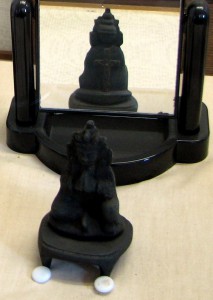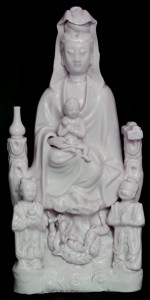
Dehua Kilns Maria Kannon
Dehua Kilns
Porcelain Statue
17th century
Tokyo National Museum
In 1549, missionaries brought Christianity to Japan. It soon became popular that Tokugawa Ieyasu began to fear that Christians were more loyal to their faith than his shogunate. In 1612, Christianity was banned in the country and whoever practiced it were persecuted, often with violence, and in the coming years was even fiercer. It was banned for over two centuries during the Tokugawa Era known as the Edo Period. Authorites were eager to eradicate this foreign religion that they excuted and imprisioned thousands of Christians and ordered all families to register with local Buddhist parishes.
Thus to conceal their faith, Christian had to stay low profile and their faith had to be private. They were known as the Kakure Kirishitan, or Hidden Christians. Since then their faith was forced to go underground, and follower had to find private ways to practice it. In the mid-17th century, outlawed Christians created statues of Virgin Mary (Mother of Jesus) disguised as the Buddhist deity Kannon (Goddess of Mercy, Guanyin). These statues are known as Maria Kannon. Maria Kannon was made or altered to look like Kannon (Goddess of Mercy), however they were not worshipped as Kannon. This is for safety purposes for the Christian who practices their faith in secret. Part of their creation of the statues, they had many version of Maria Kannon that looks like Kannon ranging from “Byakue Kannon”, “Jibo Kannon”, to Guanyin(Kannon) and Child of many different sizes. There are some that have a cross-hidden within the image or had a Christian icon hidden inside the body of the camouflaged artwork.
For instance, Dehua Kilns Maria Kannon is depicted as one of Kannon feminine form Koyasu Kannon (子安観音) that means child giving and child rearing, which resemble “Byakue Kannon” in appearance but she is holding a child. If you look at it with a Christian point of view, doesn’t it feels like it is depicting Virgin Mary and Baby Jesus. In addition to its white robe, according to Christianity, it represents purity and righteousness and served as a symbol of salvation. This statue is made white with Dehua white porcelain, which can be known as “hakugorai” or “Korean White Ware” in traditional Japanese. Based on the material used to make for this statue, it tells that instead of it being made in japan, it is produced in Dehua Kilns, known for their porcelain that is located in Fujian Province opposite the island of Taiwan. Therefore it shows that Dehua Kilns Maria Kannon is imported to Japan for the hidden Christian’s underground use. The reason partly that Japanese uses such material is due to the fact that they associate very plain white with object for Japanese religious and ritual observance. Another reason for the use of such material is that it can produce a pure white colouring for the object. Since it is made in China, Chinese believe that white is the colour of filial piety and , death and mourning. Therefore they are usually used to make devotional characters such as statues and incense burners.
At the back of the statue, a hidden Christian cross can be found. This icon serve to conceal the Christian’s faith while they pretended to be Buddhist. The Christians would honor this statue by silently praying to Mother Mary. Due to having such method it create a sense of relief for the follower as to the outsider it appeared Buddhist, whereas to the outlawed Christian, it appeared as an object of Christ faith. These secretive methods fool the government and help them to keep their faith hidden and alive.
References & Further Reading:
Mark Schumacher. Virgin Mary & Kannon, Two Merciful Mothers (1995 – 2014), Retrieved from November 3, 2015, from
http://www.onmarkproductions.com/html/maria-kannon.html
R.W.Smith. Dehua Kilns, “Dehua Kilns Maria Kannon,” The Christian Kannon, The Buddhist Madonna, Retrieved from November 3, 2015, from http://rwsmith.omeka.net/items/show/44
Dunoucou. Chinese Porcelain (October 3, 2008), Retrived from November 3, 2015, from
http://oblogdourbano.blogspot.sg/2008/10/dehua-white-porcelain-in-japan.html
Chris Morrison. John Dougill: In Search of Japan’s Hidden Christians, (June 8, 2012), Retrieved from November 3, 2015, from
https://32minutes.wordpress.com/2012/06/08/john-dougill-in-search-of-japans-hidden-christians/
Chelsea Foxwell. Merciful Mother Kannon and Its Audiences (2010), Retrieved from November 3, 2015, from
http://isites.harvard.edu/fs/docs/icb.topic1524561.files//Foxwell_Merciful_Mother_Kannon.pdf

Good introductory paragraph. Need dates for Edo period.
Thoughtfully written and information well organised. But needs a lot of editing (repetition and grammatical errors).